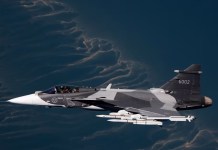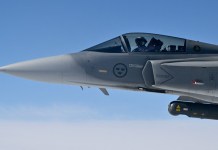Since India’s Operation Sindoor in May this year, the Indian Air Force (IAF) has hogged the limelight. However, quietly in the shadows, the Indian Navy is spreading its fangs from the Mediterranean to the Indo-Pacific, in the process irking not only Pakistan, but a host of countries from Turkey to China.
Since its independence in 1947, India has fought five land-based wars (1948, 1962, 1965, 1971, 1999) with China and Pakistan; however, the Indian Navy was in action in only one of them (1971).
The presence of contested borders with Pakistan and China in the North and Northwest means that Indians are generally forgetful of the fact that India also has one of the world’s longest coastlines, running nearly 11,098 km.
However, the role of the Indian Navy is not limited to protecting this thousands-of-miles-long coastline.
India sees itself as a ‘net security provider’ in the Indian Ocean Region (IOR), from the Red Sea to the Malacca Straits.
In fact, lately, the Indian Navy has also expanded its reach beyond the IOR into the Mediterranean, the Indo-Pacific, and even the Arctic Ocean, conducting joint naval drills, free passage exercises, and exploratory missions to these far-off waters.
In the process, the Indian Navy (IN) is triggering anxiety, nervousness, and insecurity in many countries, which are finding it hard to accept the expanding reach of the IN.
Chinese Analysts Concerned
According to Chinese analysts, Beijing is likely to view the growing defense cooperation between India, South Korea, and Australia as a strategic effort to contain China in the Indo-Pacific.
They say that by forging closer defense ties, these countries are trying to fill the vacuum left by the US’s strategic withdrawal from the region.
The Chinese analysts were responding to the presence of the Indian naval vessel Sahyadri in China’s backyard.
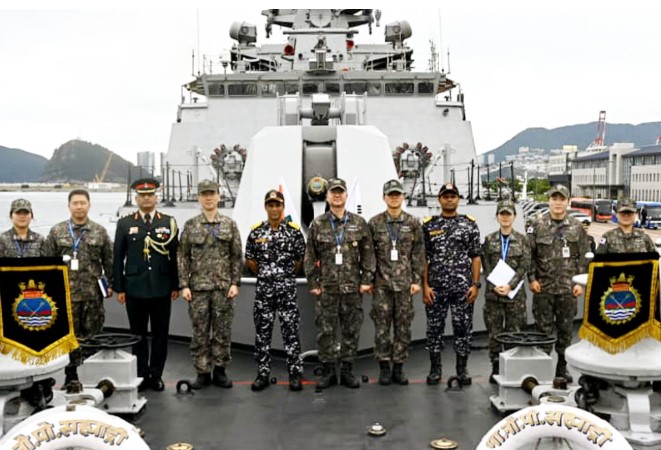
According to a statement by India’s Ministry of Defense, Sahyadri docked at Busan naval port in South Korea on October 13.
“Indian Naval Ship Sahyadri, as part of ongoing operational deployment to the South China Sea and Indo-Pacific, made a port call at Busan Naval Harbour, South Korea, on 13 Oct 2025 to participate in the maiden Indian Navy (IN) – Republic of Korea Navy (RoKN) Bilateral Exercise,” it said.
“During the visit, the ship’s crew will participate in the harbour and the sea phase of the inaugural edition of the IN-RoKN Bilateral Exercise.”
“With the ever-increasing significance of the Indo-Pacific in the geopolitical seascape, both nations have increasingly recognised the importance of building partnerships, based on mutual interests…INS Sahyadri’s ongoing operational deployment to the South China Sea and Indo-Pacific underscores India’s stature as a responsible maritime stakeholder and Preferred Security Partner,” the statement added.
Sahyadri is a Shivalik-class guided-missile stealth frigate designed by India and commissioned in 2012.
The Indian Defense Ministry’s statement highlights the growing significance of the Indo-Pacific and the South China Sea in the Indian Navy’s plans.
Additionally, earlier this month, on October 9, Indian Defense Minister Rajnath Singh visited Canberra for the inaugural Australia–India Defense Ministers’ Dialogue with his counterpart, Richard Marles.
During the talks, both sides affirmed the importance of boosting cooperation with regional partners to help maintain a free, open, peaceful, stable, and prosperous Indo-Pacific, according to a statement released by Canberra.
Liselotte Odgaard, a senior fellow at the Hudson Institute in Washington, said the developments in the India-Australia defense ties would be seen in Beijing as “strengthening containment of China in the Indo-Pacific,” which would increase tensions in the Indian Ocean.
Those areas could become “more contested,” she added.
“The submarine rescue and logistics support agreements strengthen India’s ability to sustain operations in the Indian Ocean, challenging China’s ability to project naval power and maintain influence across both the Pacific Ocean and the Indian Ocean as part of its efforts to become a global maritime power,” Odgaard was quoted as saying by the Hong Kong-based South China Morning Post (SCMP).
Meanwhile, commenting on the India-South Korea joint naval drills, a historic first, Odgaard said that the deployment of the Indian stealth frigate in the Indo-Pacific signals India’s active presence in contested waters.
“The drill strengthens India’s position as a ‘preferred security partner’ and adds to India’s growing network of naval partnerships in East Asia, which also encompasses Japan and Vietnam, and which also tries to balance China’s maritime assertiveness.”
“India is engaging defence-wise minilateral groupings to counterbalance China while avoiding direct confrontation, expanding its defence footprint through joint exercises, logistics agreements and technology partnerships, and it is signalling to China that it is actively engaged in shaping the Indo-Pacific’s security architecture,” Odgaard added.
China would interpret India’s moves as part of a “broader encirclement strategy” led by the US and supported by regional countries, she said.
Meanwhile, a Chinese government-backed foreign policy think tank warned that closer cooperation between India and Australia could disturb “regional peace“.
In an article published on October 16, the China Institutes of Contemporary International Relations said that increased defense collaboration between the two countries had become “a new variable that cannot be ignored amid shifting geopolitical dynamics”.
These alarmist responses by Chinese analysts echo similar sentiments expressed by the Turkish media last month when an Indian warship sailed through the Mediterranean to participate in joint naval drills with Greece.
Beijing Lashed Out At India-Philippines Naval Drills
In August, the Indian Navy warships conducted bilateral drills with the Philippine Navy in the contested South China Sea, focusing on maritime security and interoperability.
Beijing lashed out, calling India a “third party” with no right to interfere and accusing it of “stirring up trouble.”
The Chinese Foreign Ministry Spokesperson Guo Jiakun said disputes over territory and maritime rights and interests should be settled through negotiation and consultation by the countries directly concerned.
“No third party is in any position to interfere,” Gao added, when asked about the India-Philippines joint exercises in the South China Sea.
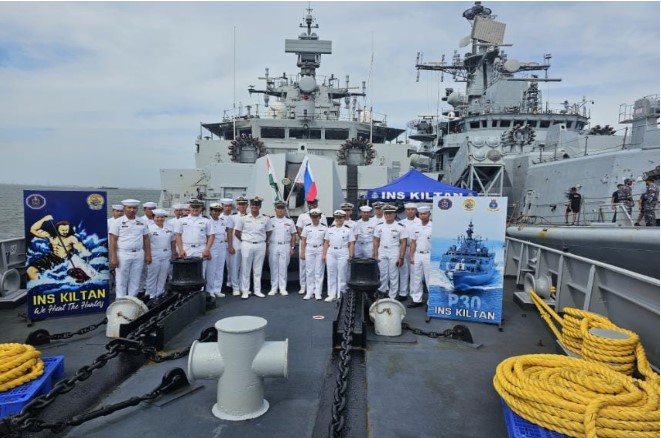
Xu Liping, director of the Center for Southeast Asian Studies at the Chinese Academy of Social Sciences, told the Chinese state-run media outlet Global Times that Manila’s attempts to rope in outside parties are both unwise and counterproductive.
“India’s interference, as an extraterritorial actor, is neither reasonable nor responsible,” Xu said, adding that India’s involvement only escalates tensions in the South China Sea.
Meanwhile, the Chinese People’s Liberation Army (PLA) sternly opposed the drills, calling the war games a “destabilising move” and slamming the Philippines for “bringing in external forces to stir up trouble in the South China Sea.”
Chinese navy ships, including a guided-missile destroyer, shadowed the Indian and Philippine vessels during the naval drills, underscoring the PLA Navy’s anxiety.
Indo-Greek-Cypriot Joint Naval Drills Irk Turkey
The INS TAMAL conducted Passage Exercises (PASSEX) with the Greek Navy’s missile cruiser RITSOS in Souda Bay in August this year.
INS Trikand followed with PASSEX drills alongside Cypriot vessels at Limassol port in September, including anti-submarine warfare, night boarding, and gunnery operations.
#IndianNavy – #HellenicNavy Maiden bilateral maritime exercise concluded on #18Sep 25 in the Mediterranean Sea, marking a milestone in India-Greece defence cooperation.
Harbour phase (13-17 Sep) included cross-deck visits, professional exchanges, a pre-sail conference onboard… https://t.co/V7EpESU1z5 pic.twitter.com/Q6ZbhWwJoo
— SpokespersonNavy (@indiannavy) September 20, 2025
The Turkish media reacted sharply to the Indian Navy’s participation in these naval drills.
Dr Ahmet Keser, a professor at Türkiye’s Hasan Kalyoncu University, told Turkish state-controlled TRT World that the India-Greece rapprochement should be seen as a calculated strategy by Athens to counter Ankara.
“One of the core strategies consistently followed by Greece and the Greek Cypriot administration is to strengthen relations with countries that are either experiencing tensions with Türkiye or have the potential for such tensions,” he said.
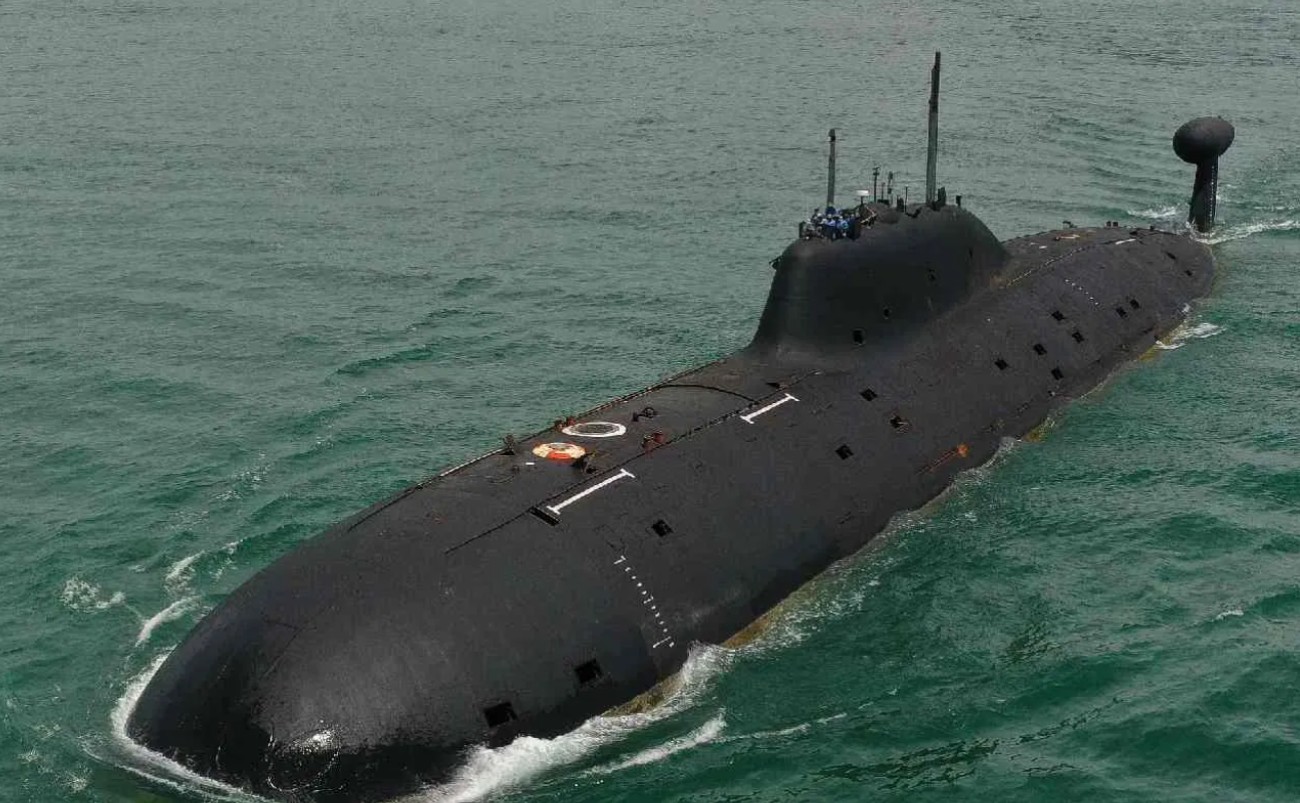
For India, Keser argued, the motivation is equally strategic: A response to Türkiye’s support for Pakistan during the brief but intense four-day war in May 2025.
Mushahid Hussain Sayed, a foreign affairs expert who previously served as Pakistan’s federal minister and long-time senator, told TRT World that India’s move was driven by “animus towards Türkiye” due to Ankara’s strategic partnership with Islamabad.
He argued that India’s military drills with Greece were a “symbolic response” to the substantive defense cooperation between Türkiye and Pakistan.
Notably, even during Operation Sindor in May, the Indian Navy was out in the Arabian Sea, ready to strike Pakistan as soon as it received orders.
India has also made it clear that in the next confrontation with Pakistan, New Delhi will not hesitate to bring in its formidable navy.
Earlier this week, the Indian Prime Minister Narendera Modi spent Diwali festival on board India’s indigenous aircraft carrier INS Vikrant, underscoring the rising importance of the Indian Navy in New Delhi’s security calculus.
These joint naval drills with countries as diverse as Greece, Cyprus, South Korea, the Philippines, and Australia underscore the Indian Navy’s growing reach, which is no longer satisfied with protecting India’s coastline or serving as the net security provider in the IOR.
The Indian Navy has made it clear that it aspires to be a “blue water navy,” and is willing to “ruffle some feathers” to achieve its objectives.
- Sumit Ahlawat has over a decade of experience in news media. He has worked with Press Trust of India, Times Now, Zee News, Economic Times, and Microsoft News. He holds a Master’s Degree in International Media and Modern History from the University of Sheffield, UK.
- VIEWS PERSONAL OF THE AUTHOR.
- He can be reached at ahlawat.sumit85 (at) gmail.com

